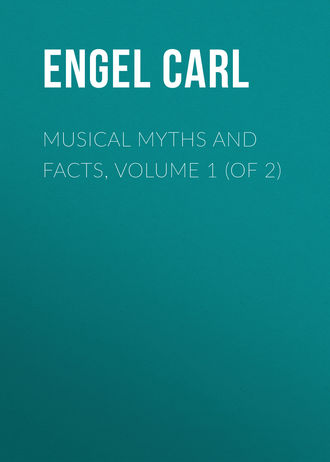 полная версия
полная версияMusical Myths and Facts, Volume 1 (of 2)
Our great composers had generally instruction in singing very early. Indeed, a composer who has not cultivated his voice in childhood is not likely to write vocal music so effectively as would be the case if he had accustomed himself to sing his melodies while inventing them. Even the melodious phrases in his instrumental compositions are likely to be more impressive if he has been a singer from early age.
Furthermore, the young student has to learn to play in a high degree of perfection at least one musical instrument. The pianoforte is – in our time, perhaps – the best suited for his purpose, on account of the harmony and of the arrangement of orchestral works executable on the instrument. Most of our great composers were pianists, harpsichord players, or organists. There are, it is true, exceptions. Gluck's instrument was the violoncello; Spohr's, the violin. But even composers who are not pianists, generally, while composing for the orchestra, make use of the pianoforte.
The best musical performer is he who can play the most simple melody with the greatest expression; and the second best is he who can play the most difficult passages with the greatest correctness. Some pianists of astonishing manual dexterity are unable to play a simple tune with proper expression; others cannot execute well a technically easy sonata by Mozart, because they have not learnt – or, perhaps, have forgotten – the pure expression required for such unaffected music. The execution of many modern pianists is best suited for the performance of their own compositions.
If the young musician is bent upon becoming a distinguished virtuoso, it may easily be disadvantageous to him as a composer, not only on account of the time he will require for practising his fingers, but also because his fingers are apt to induce him to compose for them instead of for the heart. A great composer generally plays one instrument masterly; and he has, probably, found it expedient to learn another instrument or two besides that which he has principally cultivated. If, in addition to the pianoforte, he can play the viola or violoncello in a quartet, or Bach's pedal-fugues on the organ, he possesses the means of familiarising himself more thoroughly with many of our classical compositions than he could possibly do by merely hearing or reading them; and the familiarity thus acquired is beneficial to him. Moreover, some practical experience with wind-instruments is useful to the composer of orchestral works. Our great masters knew this, and acted upon it.
The exercise of the fingers takes up time, but not necessarily much. One hour of practice with great attention is better than three hours of careless practice. The former has not only the advantage that it advances the student more rapidly, but also that it leaves him the time required for other studies, reading, and recreation. Several of our great composers could be named who, notwithstanding their diligent studies from their youth, always found plenty of time for bodily exercise, and for amusements conducive to the preservation of health and energy – such as pedestrian tours, riding, fencing, swimming, dancing, etc.
The young musician has soon to commence the study of the theory of music, especially if he exhibits decided talent for composing. He must learn to write with facility any musical composition strictly according to the rules which have been laid down by our theorists as they found them observed in the works of the great masters. When he has acquired the skill to write correctly and fluently in the different forms of composition, it will be early enough for him to disregard the rules occasionally where he thinks it advisable for his purpose. Perhaps he may establish a new one. By far the greater number of our rules of composition are not dictated by any physical law traceable in acoustics, but only by human taste, which is continually undergoing modifications in the course of time. Thus, most of our great composers have caused some alterations in our theory of music. It is not only possible, but probable, that in a hundred years' time we shall have admirable musical compositions very different in form and construction from our present ones.
Several of our great composers in their youth excelled in extemporising. They were fond of it, and spent many an hour in pouring forth on their favourite instrument their momentary inspirations and fanciful conceptions. Extempore fantasias are sometimes so original and effective that it is a pity they cannot be preserved by being committed to notation at the moment of their creation. However, charming as such spontaneous effusions may be on account of their freshness, they do not possess the artistic value of an elaborately constructed and carefully finished work. At any rate, our great composers have in their youth derived greater benefit from carefully working out in notation a theme according to a certain form of composition, than from indulging in extempore fantasias. These have, however, often helped them in creating beautiful ideas for their works.
It may easily be understood that a retentive memory is of great value to the musician, be he composer or merely performer. Talented young musicians not unfrequently possess an astounding memory. Sonatas, symphonies, and even fugues, which they practise, they can soon play by heart. As they advance in years the power of memory generally becomes somewhat weaker. Blind musicians appear to preserve it undiminished for a longer period than others. The blind flutist Dulon knew 120 flute concertos by heart, which he had numbered, and any one of which he could play instantly on its number being mentioned to him. True, there is musically little gained by burdening the memory with compositions which chiefly consist of compilations of passages calculated to display the dexterity and skill of the performer. The works which the musician ought to be able to recall to his memory are the classical works, such as Gluck's 'Iphigenia in Tauris,' Mozart's 'Don Giovanni,' Beethoven's Symphonies, Handel's 'Messiah,' Bach's 'Passion according to St. Matthew.' There are not a few among our great composers who studied the master-works of their predecessors so effectually that they knew by heart a considerable number of them from beginning to end, with the instrumentation of every bar.
As regards the different forms of composition, that of the sonata is the most important; for, if the composer is able to express his ideas with facility in this form, he possesses the key to all the other forms – except some of the older ones, as that of the fugue. Certain theorists recommend the student of composition to select a sonata by Mozart, or some other master, in which the established form is strictly adhered to, and to write a precisely similar sonata by imitating the model bar for bar, using the same time, tempo, modulations, changes in loudness, and so on – only substituting other notes. No doubt he may thus manufacture a sonata which is correct in form, whatever it may be in spirit. Our great composers did not arise from students trained to make music as the shoemaker makes shoes.
The form of the fugue has already become antiquated, and that of the sonata is more and more neglected by our present composers, and apparently will likewise become antiquated in the course of time. But until we have beautiful examples of some new form, it is not probable that those forms which have been gradually brought to a high degree of perfection will be entirely dispensed with, whatever modern composers may produce exhibiting an indifference to the rules observed by their predecessors.
Our great composers were particularly careful in the choice of the theme. This is only what might be expected. An orator who discourses on an uninteresting subject will not easily command the attention of his hearers. Still, if he is gifted with extraordinary powers of eloquence, he may discourse on almost any subject interestingly. Thus also in music. Beethoven and other great composers have occasionally chosen a theme which becomes significant only from its original and spirited treatment.
The artistic charm of a well-constructed composition consists in the development of the theme, so that it is exhibited in a variety of beautiful aspects – appearing, though always the same, yet always new. The skill of thus treating the theme, our great composers, by constant study and practice, have cultivated to an admirable degree of perfection. They were fully aware that it is as indispensable to the composer as is the power of creating an interesting musical idea. However, the development of the theme may be carried too far. It appears pedantic when it is contrived more with regard to the form than to the spirit of the music; and it disturbs the unity of the composition when the theme is so much changed as to appear an entirely new idea. Schubert, in his pianoforte sonatas, has not unfrequently altered the theme so much that its second exposition does not bear the required resemblance with its first; it becomes another theme, which is not wanted. For the clever development of a theme Schubert did not possess sufficient practical experience acquired by systematic study. Had he possessed a full command over the rules of the art – and especially, had he written less hastily – he might, with his wonderful gifts, have been as great a composer as Beethoven.
A few examples from Beethoven's book of sketches may find a place here, since they throw some light upon his studies. The alterations which he marked with "meilleur" are generally decided improvements upon the first notation of the idea to which they refer. This is, for instance, strikingly apparent in his sketches of his famous song 'Adelaide,' the beginning of which, noted down at first thus: —

he afterwards altered into: —

The following sketches from Beethoven's pocket-book refer to his Quartet in C♯ minor, Op. 131, with which they must be compared to render the several attempts at improvement more clearly intelligible: —



The first sketches for a tenth symphony, which Beethoven intended to compose, are noted by him thus: —
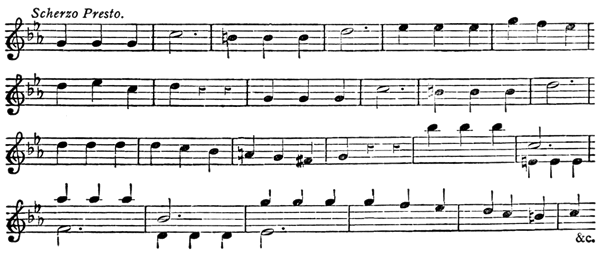



Beethoven wrote As over the little fragment of the Andante, evidently to indicate that he intended it to be in A flat major —As signifying in German A flat.
As an interesting specimen of Haydn's sketches, the following notation of his first design of the earthquake in the 'Seven Last Words' may serve. The entire sketch of which this is a fragment, has been published in the 'Allgemeine musikalische Zeitung,' Leipsig, 1848: —
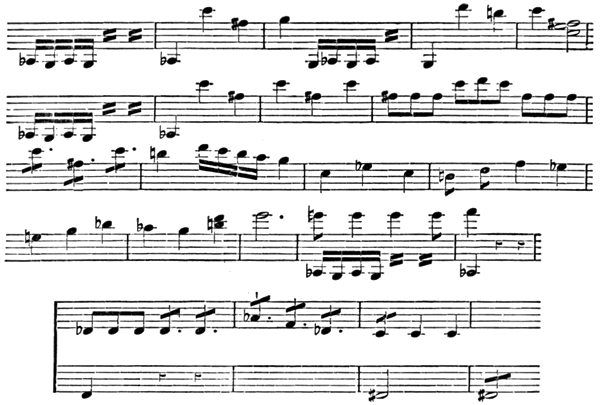
Haydn, as well as Beethoven, generally used one staff for his first sketches; Mozart made them more clear by using two staves – one for the melody and another for the bass. Still, as the sketches are only indications to assist the memory, which is, as we have seen, in composers generally very strong, especially when their own inventions are concerned, a hasty notation is in most instances sufficient. In writing the score of an orchestral composition, Haydn, Mozart and Beethoven usually noted down the entire thread of a movement, or what may be called the melody and the bass of the piece; and having written this, they inserted the notation for the various instruments.
In submitting the manuscript of a composition to a final revision, or in preparing a new edition of a published work, our great composers have not unfrequently introduced improvements which testify to their unabating study as well as to their delicacy of taste and discernment. One or two examples in support of this opinion shall be pointed out here. Others will probably occur to the musical reader.
André, in Offenbach, has published the score of the overture to the 'Zauberflöte' (the Magic Flute), from Mozart's original manuscript, with its alterations and corrections. This interesting publication exhibits clearly the care bestowed by Mozart upon the work, and affords an excellent study for the musician.
A remarkable improvement by extension occurs in Mozart's famous Symphony in C major. Mendelssohn speaks of it with admiration in a letter to Moscheles as follows: "Just now André sends me for inspection the original score of Mozart's C major Symphony ('Jupiter'); I shall copy something from it for you which will amuse you. Eleven bars before the end of the Adagio it stood formerly thus: —

and so on, as it proceeds to the end. Mozart has written the entire repetition of the theme on an inserted leaf; he has struck out the passage, and has introduced it three bars before the end. Is that not a happy alteration? The repetition of the seven bars belongs to my most favourite portions of the whole symphony."28
The Adagio of Beethoven's Sonata in B flat major, Op. 106, originally commenced with its present second bar thus: —

Beethoven had sent, in the year 1819, a copy of the manuscript of this sonata to Ferdinand Ries, in London, who had undertaken to superintend its publication in England. Great must have been the astonishment of Ries when, soon after the arrival of the bulky manuscript of this gigantic sonata, he received a letter from Beethoven containing the notation of an additional single bar: —
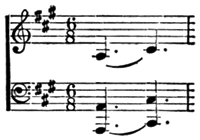
to be placed at the beginning of the Adagio. The beautiful effect obtained by the alteration is especially noteworthy, inasmuch as it serves as an example of the incessant care which Beethoven bestowed upon the improvement of his compositions up to the last moment of their publication.
Probably no composer has revised his manuscripts more carefully, and re-written whole pieces with the view of improving them, than has J. S. Bach. His forty-eight Preludes and Fugues, entitled 'Das wohltemperirte Clavier,' afford instructive examples of improvements, which may be traced by a comparison of the several editions of the work, and especially by an examination of the several manuscripts of these preludes and fugues in Bach's handwriting which have been preserved.
The prelude in C major, in the first set, was originally longer than in subsequent revisions. The second half, which Bach has struck out, was a repetition of its first half.
The prelude in C♯ major, in the first set, he has curtailed by striking out thirty-five bars. This he did evidently for the purpose of increasing the unity of this charming composition by discarding what was foreign to its character, as indicated by the theme.
On the other hand, the beautiful prelude in D minor, in the same set, he has considerably enlarged.
These few remarks must suffice to draw the reader's attention to the careful reconsideration given by Bach to 'Das wohltemperirte Clavier.'
Beethoven generally kept his manuscripts a long time by him, and altered and polished them up gradually. This he did especially with the manuscripts of his earlier compositions. Gluck, in composing an opera, carried out in his mind the principal airs and choruses before he wrote down a note; so that, when he began to commit the music to paper, he considered his opera as almost finished. Mozart, too, had sometimes a whole new composition in his head before he commenced writing it down. The overture to 'Don Giovanni' he is recorded, by some of his biographers, to have composed a few hours before the first performance of the opera, so that the copied parts for the musicians were not yet dry when they were carried into the orchestra. Probably Mozart did not compose the overture when he committed it to paper, but had it ready in his head. He was often composing when otherwise occupied, and even while he was playing billiards.
A musical composer may have a good reason for preserving the manuscript of his new work though he considers it a failure. He may wish to refer to it after a time to ascertain whether his unfavourable opinion remains unchanged on a subsequent examination. Perhaps it contains ideas which he may be glad to employ in later years when his power of invention begins to flag. Still, a celebrated musician would do wisely to destroy any such manuscripts when he no longer requires them; otherwise they are sure to arise against him after his death as posthumous works. They will, at least, lower his fame, if it is too great to be seriously injured by them. In truth, there is often harm done to art as well as to artists by these posthumous publications – in most instances weak productions which have been permitted to live from carelessness of the composers, or perhaps from the natural affection which a father feels for even his most ill-favoured child.
Our great composers have generally been extremely cautious, especially during the earlier part of their lifetime, in selecting for publication only such of their manuscripts as they were fully justified in considering worthy of being published. As regards most musicians, it would be better for their reputation if they had published only half the number of their works, and destroyed the other half.
It is a noteworthy fact that our great composers have occasionally produced beautiful effects by disregarding the rules laid down in treatises on the theory of music. Beethoven has been not unfrequently a trespasser in this respect. Weber, in the Introductory Chorus of the elves, in 'Oberon,' produces really charming consecutive fifths. So does Handel, in the beautiful Pastoral Symphony in the 'Messiah': —
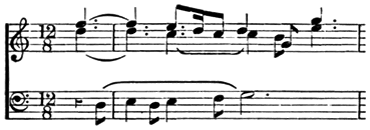
and Gluck repeatedly, in the beautiful air of Rinaldo, in 'Armida': —

Graun, in his cantata, 'Der Tod Jesu' (The Death of Jesus), introduces into the first chorale consecutive fifths upon the words "Zur Frevelthat entschlossen" (On evil deed resolved), thus: —

which, no doubt, was considered by some musicians as remarkably appropriate to the words, although, probably, they could not have heard it in the performance, had they not previously seen it in notation. Not such whims only, but even oversights and misprints occurring in the works of eminent masters have found admirers, who regarded them as strokes of genius; while, on the other hand, some of the most original and surpassingly beautiful ideas were thought to be misprints, and attempts have actually been made by theorists to correct them.
A curious instance of a misprint which by many admirers of Beethoven has been accepted as a beautiful inspiration occurs in the scherzo of his C minor Symphony. To dispel all doubt of its being a misprint, Mendelssohn caused the publishers of the Symphony to make known a letter addressed to them by Beethoven in the year 1810, in which he says: "The following mistake I still find in the C minor Symphony, namely, in the third piece, in 3/4 time, where, after C major, the minor key recommences. It stands thus (I take at once the bass part): —

The two bars marked with * are redundant, and must be struck out; of course, also in all the other parts which have rests." A reference to the manuscript in the possession of the publishers revealed how the two superfluous bars had crept in. Beethoven had originally intended that the entire scherzo, with the trio, should be repeated, and then be concluded by the coda. He had marked in the manuscript the two superfluous bars with 1, and the two following ones with 2, and had written with a red pencil, "Si replica con trio allora 2," which the engraver had not exactly understood. As also the written parts for the instruments, which were used at the first performance of the C minor Symphony in Vienna, under Beethoven's direction, do not possess those two bars, there remains not the least doubt that they were never intended by the composer to be where they are now found to the delight of many enthusiastic admirers of Beethoven.
A misprint in Beethoven's 'Sinfonia Pastorale' (which Schumann points out in his 'Gesammelte Schriften,' Vol. IV.) is almost too evident to be left uncorrected, even by those who find it beautiful. In the second part of the first movement, where the theme recommences, with the accompaniment of triplets, the score has the following notations: —
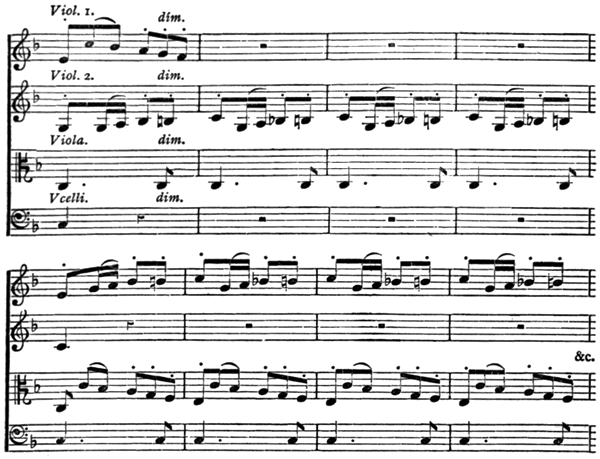
That here, by mistake, three rests for the first violins have been inserted by the engraver, instead of three simile-signs,

A carefully-compiled manual, containing reliable corrections of the most important misprints occurring in our classical compositions, would be a boon to the musical student. There are many in Bach's fugues, and even in Beethoven's sonatas, which are not easily detected, but which are on this account all the more noteworthy.
The following beautiful conception, which occurs in the first movement of Beethoven's Sinfonia Eroica, was regarded by many, on the first publication of the symphony, as a misprint: —

Ferdinand Ries, the pupil of Beethoven, was unable to appreciate the charm of this soft and timid indication of the theme on a dissonance immediately before it gloriously breaks out on the harmonious triad. In his biographical notices of Beethoven he thus speaks of it: "In the first Allegro of the Symphony there occurs a bad whim of Beethoven for the horn. Some bars before the theme enters again, in the second part of the Allegro, Beethoven indicates it by the horn, while the violins continue to sound the second-chord. This must always convey to those who are unacquainted with the score, the impression that the horn-player has counted incorrectly, and that he falls in at a wrong bar. At the first rehearsal of the symphony, which was very unsatisfactory, but in which the horn-player kept proper time, I was standing near Beethoven, and, in the belief that it was wrong, I cried: 'That confounded hornist! Can he not count! It sounds so infamously wrong!' Beethoven was near to giving me a box on the ear. It took him a long time to forgive me."


